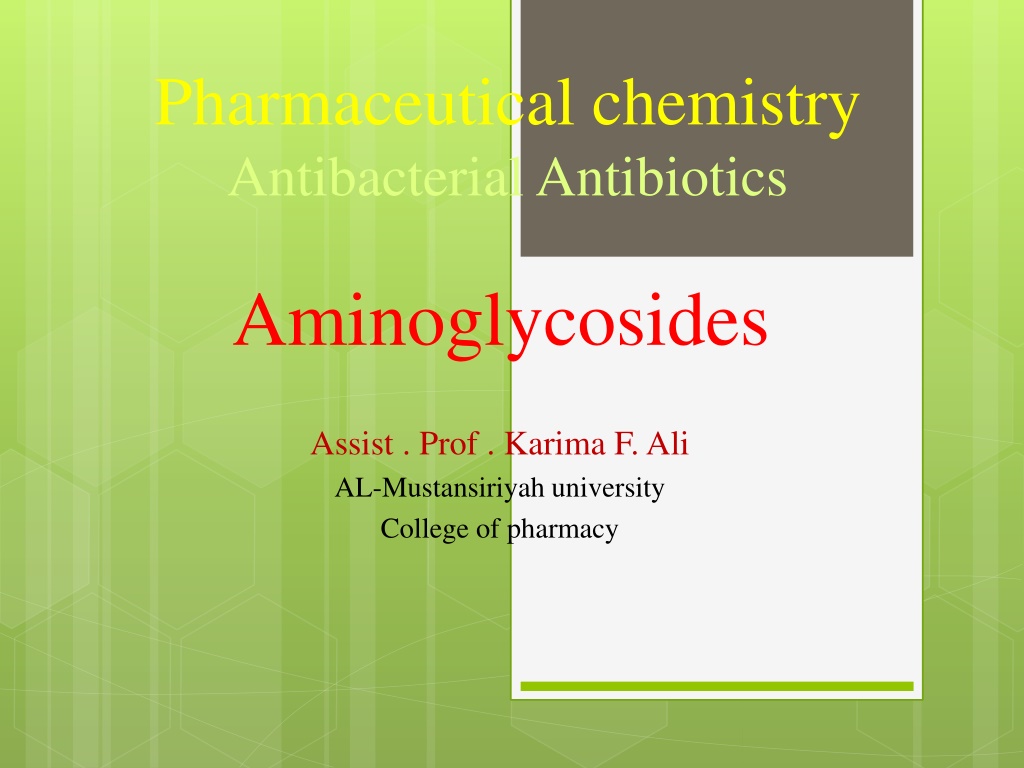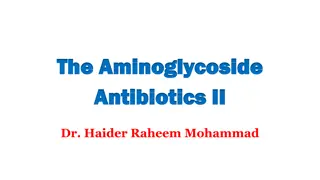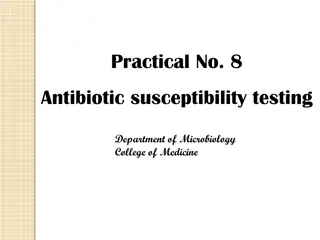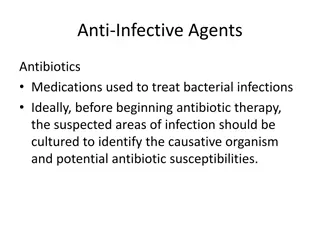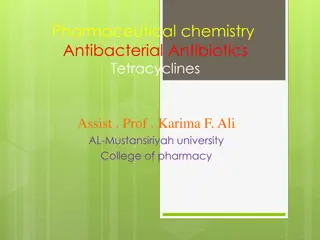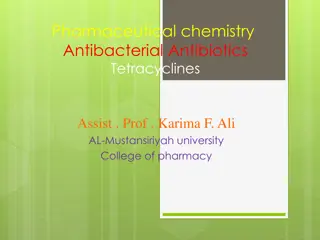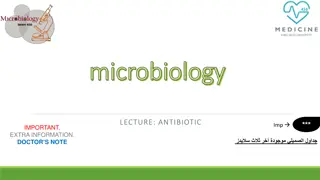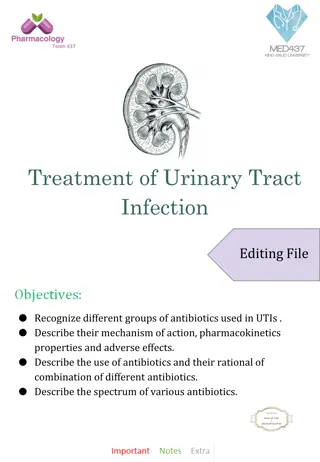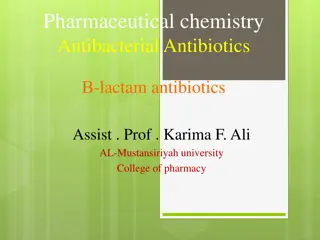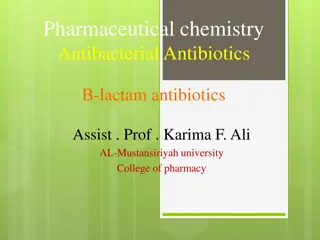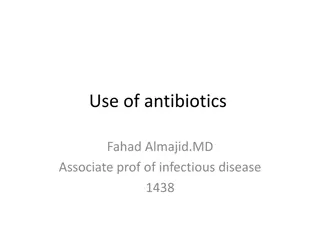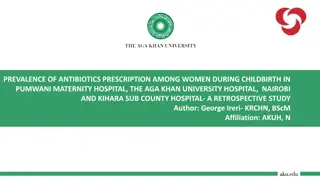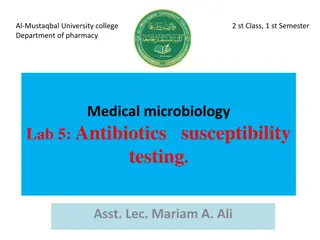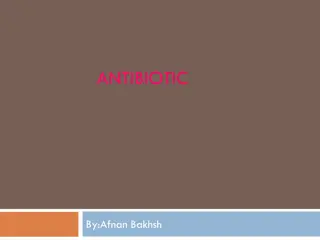Understanding Aminoglycoside Antibiotics in Pharmaceutical Chemistry
Aminoglycoside antibiotics like streptomycin, kanamycin, neomycin, and gentamicin are vital in treating serious infections caused by Gram-negative bacteria. Their mechanism of action involves inhibiting protein synthesis in bacteria. These medications are poorly absorbed orally but are effective against a wide spectrum of pathogens due to their unique chemical structure and mechanism. Resistance to aminoglycosides is a concern in microbial populations.
Download Presentation

Please find below an Image/Link to download the presentation.
The content on the website is provided AS IS for your information and personal use only. It may not be sold, licensed, or shared on other websites without obtaining consent from the author. Download presentation by click this link. If you encounter any issues during the download, it is possible that the publisher has removed the file from their server.
E N D
Presentation Transcript
Pharmaceutical chemistry Antibacterial Antibiotics Aminoglycosides Assist . Prof . Karima F. Ali AL-Mustansiriyah university College of pharmacy
Aminoglycosides Streptomycin, chemotherapy isolated from the actinomycetes and, particularly, from the genus Streptomyces. Among the many antibiotics isolated from that genus, several compounds closely related in structure to streptomycin. Six of them kanamycin, neomycin, paromomycin, gentamicin, tobramycin, and netilmicin are marketed in the United States. Amikacin, a semisynthetic derivative of kanamycin A, has been added, and it is possible that additional aminoglycosides will be introduced in the future. All aminoglycoside antibiotics are absorbed very poorly following oral administration, and some of them (kanamycin, neomycin, and paromomycin) are administered by that route for the treatment of GI infections. Because of their potent broadspectrum antimicrobial activity, first aminoglycoside antibiotic used in
Chemistry Aminoglycosides are so named because their structures consist of glycosidically. All have at least one aminohexose, and some have a pentose lacking an amino group (e.g., streptomycin, neomycin, and paromomycin). Additionally, each of aminoglycosides contains a highly substituted 1,3- diaminocyclohexane central ring; in kanamycin, neomycin, gentamicin, deoxystreptamine, in streptomycin, it is streptadine. amino sugars linked the clinically useful and tobramycin, it is
The aminoglycosides are thus strongly basic compounds that exist as polycations at physiological pH Aminoglycosides are apparently not metabolized in vivo. Their inorganic acid salts are very soluble in water. All are available as sulfates. Solutions of the aminoglycoside salts are stable to autoclaving. The high water solubility of the aminoglycosides no doubt contributes to their pharmacokinetic properties. They distribute well into most body fluids but not into the central nervous system, bone, or fatty or connective tissues.
Spectrum of Activity Although the aminoglycosides are classified as broadspectrum antibiotics, their greatest usefulness lies in the treatment of serious systemic infections caused by aerobic Gram-negative bacilli. Mechanism ofAction The aminoglycosides act directly on the bacterial ribosome to inhibit the initiation of protein synthesis and to interfere with the fidelity of translation of the genetic message. They bind to the 30S ribosomal subunit to form a complex that cannot initiate proper amino acid polymerization. The binding of streptomycin and other aminoglycosides to ribosomes also causes misreading mutations of the genetic code, and hence incorporation of improper amino acids into the peptide chain.
Microbial Resistance A pattern of bacterial resistance to each of the aminoglycoside antibiotics, however, has developed as their clinical use has become more widespread. Consequently, there are bacterial strains resistant to streptomycin, kanamycin, and gentamicin. Strains carrying R factors for resistance to these antibiotics synthesize enzymes that are capable of acetylating, phosphorylating, or adenylylating key amino or hydroxyl groups of the aminoglycosides.
Resistance of individual aminoglycosides to specific inactivating enzymes can be understood, in large measure, by using chemical principles. First, one can assume that if the target functional group is absent in a position of the structure normally attacked by an inactivating enzyme, then the antibiotic will be resistant to the enzyme. Second, steric factors may confer resistance to attack at functionalities otherwise susceptible to enzymatic attack.
StructureActivity Relationships It is convenient to discuss sequentially aminoglycoside SARs in terms of substituents in rings I, II, and III. Ring I is crucially important for characteristic broad spectrum antibacterial activity, and it is the primary target for bacterial inactivating enzymes. Amino functions at 6 and 2 are particularly important as kanamycin B (6 amino, 2 -amino) is more active than kanamycin A (6 -amino, 2 - hydroxyl), which in turn is more active than kanamycin C (6 -hydroxyl, 2 amino).
Methylation at either the 6-carbon or the 6-amino positions does not lower appreciably antibacterial activity and confers acetylation of the 6 -amino group. Removal of the 3 -hydroxyl or the 4 -hydroxyl group or both in the kanamycins dideoxykanamycin B or dibekacin) does not reduce antibacterial potency. The gentamicins lack oxygen functions at these positions. sisomicin and netilmicin, which also have a 4 5 - double bond. resistance to enzymatic (e.g., 3 ,4 -
So these derivatives is not inactivated by phosphotransferase enzymes that phosphorylate the 3 hydroxyl group. Evidently, the 3 -phosphorylated derivatives have very low affinity for aminoglycoside-binding sites in bacterial ribosomes. Few modifications of ring II (deoxystreptamine) functional groups are possible without appreciable loss of activity in most of the aminoglycosides. 1. The C1-amino group of kanamycin A can be acylated (e.g., Amikacin), however, with activity largely retained.
2. Netilmicin(1-N-ethylsisomicin) derivative prepared by reductive ethylation of NH2 of C1 in sisomicin retains the antibacterial potency of sisomicin and is resistant to several additional bacteria-inactivating enzymes. semisynthetic 1 sisomicin Netilmicin
Ring III functional groups appear to be somewhat less sensitive to structural changes than those of either ring I or ring II. 1. The 2 -deoxygentamicins are significantly less active than their 2 -hydroxyl counterparts. 2. The 2 -amino derivatives (seldomycins) are highly active. 3. The 3 -amino group of gentamicins may be primary or secondary with high antibacterial potency. Furthermore, 4. The 4 - hydroxyl group may be axial or equatorial with little change in potency.
Gentamicin structure Ring l Ring lll
Products Streptomycin Sulfate, Streptomycin acts as a triacidic base through the effect of its two strongly basic guanidino groups and the more weakly basic methylamino group Acid hydrolysis yields streptidine and streptobiosamine,
Because streptomycin is not absorbed when given orally or destroyed significantly in the GI tract, at one time it was used rather widely in the treatment of infections of the intestinal tract. For systemic action, streptomycin usually is given by intramuscular injection. The organism that produces streptomycin, S. griseus, also produces several other antibiotic compounds: Hydroxystreptomycin, Mannisidostreptomycin, and cycloheximide Hydroxystreptomycin differs from streptomycin in having a hydroxyl group in place of one of the hydrogen atoms of the streptose methyl group. Mannisidostreptomycin has a mannose residue attached in glycosidic linkage through the hydroxyl group at C-4 of the N-methyl-L- glucosamine moiety. Of these, only cycloheximide has achieved importance as a medicinally useful substance.
Neomycin Sulfate It is considered one of the most useful antibiotics for the treatment of GI infections, It has broad-spectrum activity against various organisms and shows a low incidence of toxic and hypersensitivity reactions. It is absorbed very slightly from the digestive tract, so its oral use ordinarily does not produce any systemic effect.
neomycin B differs from neomycin C by the nature of the sugar attached terminally to D-ribose. That sugar, called neosamine B, differs from neosamine C in its stereochemistry.
Kanamycin Sulfate Chromatography showed that S. kanamyceticus elaborates three closely related structures: kanamycins A, B, and C. Commercially available kanamycin is almost pure kanamycin A, the least toxic of the three forms. The kanamycins differ only in the sugar moieties attached to the glycosidic oxygen on the 4- position of the central deoxystreptamine
The kanamycins do not have the D-ribose molecule that is present in neomycins and paromomycins. Perhaps this structural difference is related to the lower toxicity observed with kanamycins. Kanamycin Acontains 6-amino-6-deoxy-D-glucose Kanamycin B contains 2,6-diamino- 2,6-dideoxy-D- glucose Kanamycin C contains 2-amino-2-deoxy-D-glucose The use of kanamycin in the United States usually is restricted to infections of the intestinal tract (e.g., bacillary dysentery) and to systemic infections arising from Gram negative bacilli.
Amikacin 1-N-amino- -hydroxy butyryl kanamycinA(Amikin), is a semisynthetic aminoglycoside first prepared in Japan. The synthesis formally involves simple acylation of the 1 amino group of the deoxystreptamine ring of kanamycinA. The remarkable feature of Amikacin is that it resists attack by most bacteria-inactivating enzymes and, therefore, is effective against strains of bacteria that are resistant to other aminoglycosides, including gentamicin and tobramycin.
Gentamicin Sulfate I III II Gentamicin is composed of a number of related gentamicin components and fractions which have varying degrees of antimicrobial potency. The main components of gentamicin include members of the gentamicin C complex: gentamicin C1, gentamicin C1a, and gentamicin approximately 80% of gentamicin and have been found to have the highest antibacterial activity. Gentamicin A, B, X, and a few others make up the remaining 20% of gentamicin and have lower antibiotic activity than the gentamicin C complex C2 which compose
